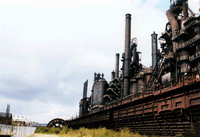America to learn about its industrial history through Bethlehem Steel company
History is going to expore the massive ruins of Bethlehem Steel, once the industrial behemoth that armed hundreds of U.S. warships, provided the raw material for the Golden Gate Bridge and transformed the New York City skyline.

Thanks to an $800 million (545 million EUR) casino complex rising on the site, the dream that has eluded preservationists for more than a decade is now within reach: the ability to tell the story of America's industrial history through the prism of one of its most important companies.
An estimated 5 million people a year are expected to come to south Bethlehem to gamble and shop once Las Vegas Sands Corp. opens the doors of its slot-machine casino in the spring of 2009. These visitors could help provide the economic shot in the arm necessary to stabilize and maintain many of the historic buildings, making them suitable for public display.
No one knows how much it will cost to preserve the Bethlehem Steel story, or who will agree to pay for what. But Sands has already saved 20 buildings from the wrecking ball, and those who are passionate about "the Steel" say that some kind of public access is a certainty.
"It's a terrific opportunity," said Howard Gillette, a history professor at Rutgers University in New Jersey. "Bethlehem tells the whole story of industrialization in America, and deindustrialization."
Gillette heads the university's Mid-Atlantic Regional Center for the Humanities, or MARCH, which won a $45,000 (30,648 EUR) grant from the National Endowment for the Humanities earlier this year to develop a blueprint for the preservation and eventual historical interpretation of the Bethlehem Steel works.
With so many buildings still standing, "there's an enormous amount of interpretation that can be done. You can't find that anywhere else in the world," said Amey Senape, who manages the Lehigh Valley Industrial Heritage Coalition, an alliance of community groups that is helping coordinate preservation efforts at Bethlehem Steel.
Sands has consistently expressed support for the goal of telling the Steel's story. The company has already dedicated the oldest building on the site, the circa-1860s Stock House, to the city for use as a visitors center.
Though Sands officials were unavailable for comment earlier this week, the company said in its latest filing with the Securities and Exchange Commission: "The goal of Las Vegas Sands Corp. is to bring life back to this historic site, while respecting the fascinating and valuable legacy that it represents for the people of Pennsylvania and the world."
Originally a producer of iron rails for railroads, the sprawling plant along the Lehigh River began making steel in 1873 and, by the 1880s, was producing weapons and armor for the U.S. Navy. At its height during World War II, Bethlehem Steel was the top U.S. military contractor and the plant, which comprised 20 percent of the city's land mass, employed more than 31,000 workers.
The company's economic might was symbolized by the 1,500- foot- (457-meter) long No. 2 Machine Shop, once the world's largest, and by the 20-story blast furnaces that have dominated Bethlehem's skyline for 100 years.
By the close of the 20th century, however, bloated labor costs and foreign competition had helped spell the demise of Bethlehem Steel and many other domestic producers. Steelmaking in Bethlehem ended on Nov. 18, 1995, and the plant became the nation's largest brownfield. Ideas for redevelopment came and went, and many of the historic structures were in danger of being torn down.
Then legalized gambling came to Pennsylvania, with the state awarding Sands a coveted slots license on the strength of its ambitious plan for Bethlehem Steel and its promise to honor the Steel's history.
Many of the buildings that Sands saved will be incorporated into the resort, which will feature a hotel, restaurants, shops, entertainment areas and a casino with 3,000 slot machines. Sands, owner of the Venetian Resort Hotel Casino in Las Vegas, began pouring concrete for the casino earlier this month.
"We feel pretty good about the openness and responsiveness of the owners. They're interested," said Senape, whose 86-year-old father worked at Bethlehem Steel for nearly 40 years.
The blueprint produced by MARCH outlines the steps that must be taken to secure funding, stabilize the buildings not being used by the Sands, and produce the interpretive displays that will tell the Steel's story.
MARCH envisions an immersive experience that will convey something of the drama and the danger of making steel. For example, it recommends stabilizing one of the blast furnaces to make it safe for visitors to witness a "multi-sensory evocation of the sound, light, smell and heat of the blast."
Mayor John Callahan said it's too early to estimate how much all of this will cost, but it will certainly be in the millions of dollars. A consultant is being hired to put together a business plan.
"It's not going to fall on any one entity," Callahan said. "It can't because it's such a massive development project."
Subscribe to Pravda.Ru Telegram channel, Facebook, RSS!


